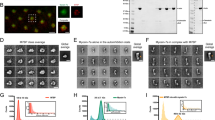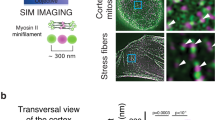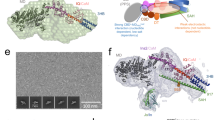Abstract
Non-muscle myosin II has diverse functions in cell contractility, cytokinesis and locomotion, but the specific contributions of its different isoforms have yet to be clarified. Here, we report that ablation of the myosin IIA isoform results in pronounced defects in cellular contractility, focal adhesions, actin stress fibre organization and tail retraction. Nevertheless, myosin IIA-deficient cells display substantially increased cell migration and exaggerated membrane ruffling, which was dependent on the small G-protein Rac1, its activator Tiam1 and the microtubule moter kinesin Eg5. Myosin IIA deficiency stabilized microtubules, shifting the balance between actomyosin and microtubules with increased microtubules in active membrane ruffles. When microtubule polymerization was suppressed, myosin IIB could partially compensate for the absence of the IIA isoform in cellular contractility, but not in cell migration. We conclude that myosin IIA negatively regulates cell migration and suggest that it maintains a balance between the actomyosin and microtubule systems by regulating microtubule dynamics.
This is a preview of subscription content, access via your institution
Access options
Subscribe to this journal
Receive 12 print issues and online access
$209.00 per year
only $17.42 per issue
Buy this article
- Purchase on SpringerLink
- Instant access to full article PDF
Prices may be subject to local taxes which are calculated during checkout







Similar content being viewed by others
References
Danowski, B. A. Fibroblast contractility and actin organization are stimulated by microtubule inhibitors. J. Cell Sci. 93, 255–266 (1989).
Straight, A. F. et al. Dissecting temporal and spatial control of cytokinesis with a myosin II inhibitor. Science 299, 1743–1747 (2003).
Gordon, S. R. & Staley, C. A. Role of the cytoskeleton during injury-induced cell migration in corneal endothelium. Cell Motil. Cytoskeleton 16, 47–57 (1990).
Gupton, S. L. et al. Cell migration without a lamellipodium: translation of actin dynamics into cell movement mediated by tropomyosin. J. Cell Biol. 168, 619–631 (2005).
Ponti, A., Machacek, M., Gupton, S. L., Waterman-Storer, C. M. & Danuser, G. Two distinct actin networks drive the protrusion of migrating cells. Science 305, 1782–1786 (2004).
Abercrombie, M., Heaysman, J. E. & Pegrum, S. M. The locomotion of fibroblasts in culture. IV. Electron microscopy of the leading lamella. Exp. Cell Res. 67, 359–367 (1971).
Svitkina, T. M., Verkhovsky, A. B., McQuade, K. M. & Borisy, G. G. Analysis of the actin-myosin II system in fish epidermal keratocytes: mechanism of cell body translocation. J. Cell Biol. 139, 397–415 (1997).
Small, J. V. & Kaverina, I. Microtubules meet substrate adhesions to arrange cell polarity. Curr. Opin. Cell Biol. 15, 40–47 (2003).
Gupton, S. L. & Waterman-Storer, C. M. Spatiotemporal feedback between actomyosin and focal-adhesion systems optimizes rapid cell migration. Cell 125, 1361–1374 (2006).
Honer, B., Citi, S., Kendrick-Jones, J. & Jockusch, B. M. Modulation of cellular morphology and locomotory activity by antibodies against myosin. J. Cell Biol. 107, 2181–2189 (1988).
Kovacs, M., Wang, F., Hu, A., Zhang, Y. & Sellers, J. R. Functional divergence of human cytoplasmic myosin II: kinetic characterization of the non-muscle IIA isoform. J. Biol. Chem. 278, 38132–38140 (2003).
Conti, M. A., Even-Ram, S., Liu, C., Yamada, K. M. & Adelstein, R. S. Defects in cell adhesion and the visceral endoderm following ablation of nonmuscle myosin heavy chain II-A in mice. J. Biol. Chem. 279, 41263–41266 (2004).
Tullio, A. N. et al. Nonmuscle myosin II-B is required for normal development of the mouse heart. Proc. Natl Acad. Sci. USA 94, 12407–12412 (1997).
Thompson, R. F. & Langford, G. M. Myosin superfamily evolutionary history. Anat. Rec. 268, 276–289 (2002).
Lo, C. M. et al. Nonmuscle myosin IIB is involved in the guidance of fibroblast migration. Mol. Biol. Cell 15, 982–989 (2004).
Sandquist, J. C., Swenson, K. I., Demali, K. A., Burridge, K. & Means, A. R. Rho kinase differentially regulates phosphorylation of nonmuscle myosin II isoforms A and B during cell rounding and migration. J. Biol. Chem. 281, 35873–35883 (2006).
Welch, M. P., Odland, G. F. & Clark, R. A. Temporal relationships of F-actin bundle formation, collagen and fibronectin matrix assembly, and fibronectin receptor expression to wound contraction. J. Cell Biol. 110, 133–145 (1990).
Pankov, R. et al. A Rac switch regulates random versus directionally persistent cell migration. J. Cell Biol. 170, 793–802 (2005).
Nishiya, N., Kiosses, W. B., Han, J. & Ginsberg, M. H. An α4 integrin–paxillin–Arf–GAP complex restricts Rac activation to the leading edge of migrating cells. Nature Cell Biol. 7, 343–352 (2005).
Watanabe, T., Noritake, J. & Kaibuchi, K. Regulation of microtubules in cell migration. Trends Cell Biol. 15, 76–83 (2005).
Helfman, D. M. et al. Caldesmon inhibits nonmuscle cell contractility and interferes with the formation of focal adhesions. Mol. Biol. Cell 10, 3097–3112 (1999).
Gartner, M. et al. Development and biological evaluation of potent and specific inhibitors of mitotic kinesin Eg5. Chembiochem. 6, 1173–1177 (2005).
Marcus, A. I. et al. Mitotic kinesin inhibitors induce mitotic arrest and cell death in Taxol-resistant and -sensitive cancer cells. J. Biol. Chem. 280, 11569–11577 (2005).
Mertens, A. E., Roovers, R. C. & Collard, J. G. Regulation of Tiam1-Rac signalling. FEBS Lett. 546, 11–16 (2003).
Katsumi, A. et al. Effects of cell tension on the small GTPase Rac. J. Cell Biol. 158,15 3–164 (2002).
Meshel, A. S., Wei, Q., Adelstein, R. S. & Sheetz, M. P. Basic mechanism of three-dimensional collagen fibre transport by fibroblasts. Nature Cell Biol. 7, 157–164 (2005).
Salmon, W. C., Adams, M. C. & Waterman-Storer, C. M. Dual-wavelength fluorescent speckle microscopy reveals coupling of microtubule and actin movements in migrating cells. J. Cell Biol. 158, 31–37 (2002).
Medeiros, N. A., Burnette, D. T. & Forscher, P. Myosin II functions in actin-bundle turnover in neuronal growth cones. Nature Cell Biol. 8, 215–226 (2006).
Waterman-Storer, C. M., Gregory, J., Parsons, S. F. & Salmon, E. D. Membrane/microtubule tip attachment complexes (TACs) allow the assembly dynamics of plus ends to push and pull membranes into tubulovesicular networks in interphase Xenopus egg extracts. J. Cell Biol. 130, 1161–1169 (1995).
Kunda, P., Paglini, G., Quiroga, S., Kosik, K. & Caceres, A. Evidence for the involvement of Tiam1 in axon formation. J. Neurosci. 21, 2361–2372 (2001).
Kaverina, I. et al. Tensile stress stimulates microtubule outgrowth in living cells. J. Cell Sci. 115, 2283–2291 (2002).
Sawin, K. E., LeGuellec, K., Philippe, M. & Mitchison, T. J. Mitotic spindle organization by a plus-end-directed microtubule motor. Nature 359, 540–543 (1992).
Yoon, S. Y. et al. Monastrol, a selective inhibitor of the mitotic kinesin Eg5, induces a distinctive growth profile of dendrites and axons in primary cortical neuron cultures. Cell Motil. Cytoskeleton 60, 181–190 (2005).
Krylyshkina, O. et al. Modulation of substrate adhesion dynamics via microtubule targeting requires kinesin-1. J. Cell Biol. 156, 349–359 (2002).
Conley, B. J. et al. Mouse embryonic stem cell derivation, and mouse and human embryonic stem cell culture and differentiation as embryoid bodies. Curr. Protocols Cell Biol. 23, 2.1–2.22 (2005).
Koivisto, L. et al. Glycogen synthase kinase-3 regulates cytoskeleton and translocation of Rac1 in long cellular extensions of human keratinocytes. Exp. Cell Res. 293, 68–80 (2004).
Takeda, K., Yu, Z. X., Qian, S., Chin, T. K., Adelstein R. S. & Ferrans, V. J. Nonmuscle myosin II localizes to the Z-lines and intercalated discs of cardiac muscle and to the Z-lines of skeletal muscle. Cell Motil. Cytoskeleton 46, 59–68 (2000).
Acknowledgements
This research was supported by the Intramural Research Program of the National Institutes of Health (NIH), National Institute of Dental and Craniofacial Research and National Heart, Lung, and Blood Institute.
Author information
Authors and Affiliations
Corresponding author
Ethics declarations
Competing interests
The authors declare no competing financial interests.
Supplementary information
Supplementary Information
Supplementary figures S1, S2, S3 and S4 (PDF 292 kb)
Supplementary Information
Supplementary Video 1 (MOV 1004 kb)
Supplementary Information
Supplementary Video 2 (MOV 1801 kb)
Supplementary Information
Supplementary Video 3 (MOV 2310 kb)
Supplementary Information
Supplementary Video 4 (MOV 2864 kb)
Supplementary Information
Supplementary Video 5 (MOV 2240 kb)
Rights and permissions
About this article
Cite this article
Even-Ram, S., Doyle, A., Conti, M. et al. Myosin IIA regulates cell motility and actomyosin–microtubule crosstalk. Nat Cell Biol 9, 299–309 (2007). https://doi.org/10.1038/ncb1540
Received:
Accepted:
Published:
Issue Date:
DOI: https://doi.org/10.1038/ncb1540



